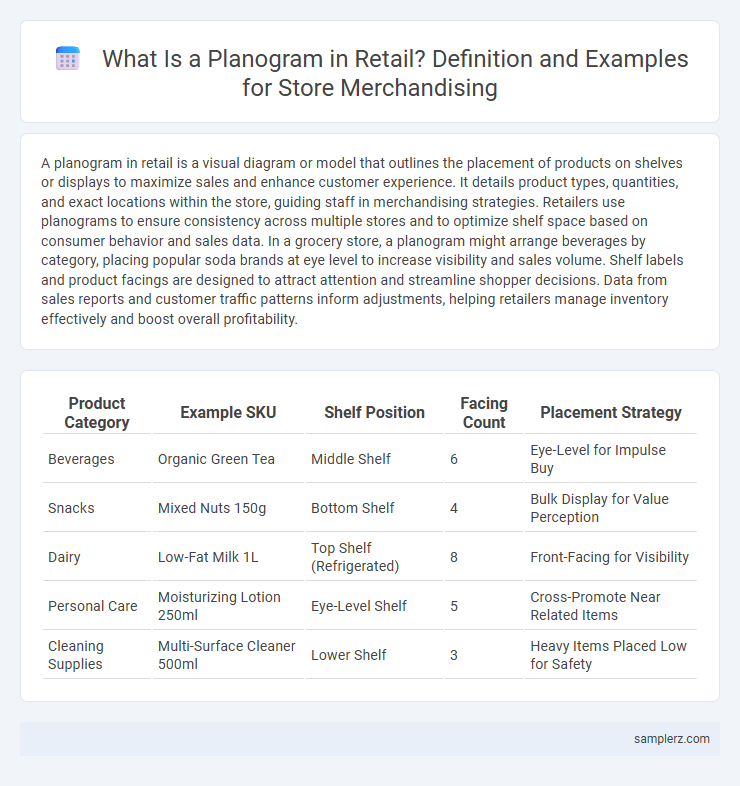A planogram in retail is a visual diagram or model that outlines the placement of products on shelves or displays to maximize sales and enhance customer experience. It details product types, quantities, and exact locations within the store, guiding staff in merchandising strategies. Retailers use planograms to ensure consistency across multiple stores and to optimize shelf space based on consumer behavior and sales data. In a grocery store, a planogram might arrange beverages by category, placing popular soda brands at eye level to increase visibility and sales volume. Shelf labels and product facings are designed to attract attention and streamline shopper decisions. Data from sales reports and customer traffic patterns inform adjustments, helping retailers manage inventory effectively and boost overall profitability.
Table of Comparison
| Product Category | Example SKU | Shelf Position | Facing Count | Placement Strategy |
|---|---|---|---|---|
| Beverages | Organic Green Tea | Middle Shelf | 6 | Eye-Level for Impulse Buy |
| Snacks | Mixed Nuts 150g | Bottom Shelf | 4 | Bulk Display for Value Perception |
| Dairy | Low-Fat Milk 1L | Top Shelf (Refrigerated) | 8 | Front-Facing for Visibility |
| Personal Care | Moisturizing Lotion 250ml | Eye-Level Shelf | 5 | Cross-Promote Near Related Items |
| Cleaning Supplies | Multi-Surface Cleaner 500ml | Lower Shelf | 3 | Heavy Items Placed Low for Safety |
Understanding Planograms: Definition and Purpose in Retail
Planograms are visual merchandising tools that strategically map product placement to optimize shelf space and enhance customer experience in retail stores. They guide retailers in organizing products based on sales data, customer behavior, and brand priorities, ensuring maximum visibility and accessibility. Effective planograms drive increased sales by aligning inventory presentation with consumer demand and store layout.
Key Elements of an Effective Store Planogram
Effective store planograms feature precise product placement based on sales data and customer behavior insights, maximizing shelf space and visual appeal. Clear categorization, strategic eye-level positioning, and consistent brand block organization drive customer engagement and increase purchase likelihood. Incorporating seasonal trends and promotional zones within the layout further optimizes inventory turnover and revenue growth.
Grocery Store Planogram Example: Shelving Layouts
A grocery store planogram example highlights shelving layouts designed to maximize product visibility and shopper convenience by organizing items based on categories, brand popularity, and consumer buying patterns. High-demand products such as dairy and bread are strategically placed at eye level, while complementary goods like jams or spreads are positioned nearby to encourage cross-selling. Shelf space allocation often follows sales data analytics, ensuring fast-moving items receive prime placement to boost inventory turnover and overall store profitability.
Fashion Retail Planogram: Arranging Apparel Displays
A fashion retail planogram strategically arranges apparel displays to maximize visual appeal and enhance customer flow within the store. Key elements include grouping clothing by style, color, and size to facilitate easy browsing and encouraging complementary product pairing such as accessories with outfits. Optimizing fixture placement and shelf height according to shopper behavior data increases engagement and boosts sales performance.
Electronics Store Planogram: Maximizing Product Visibility
An effective electronics store planogram strategically places high-demand gadgets like smartphones and laptops at eye level to maximize product visibility and boost sales. Accessories such as chargers and headphones are displayed nearby to encourage impulse purchases and enhance customer convenience. Clear signage and organized shelves further guide shoppers, reducing decision fatigue and improving overall shopping experience.
Seasonal Promotion Planogram: Holiday Merchandise Placement
Seasonal promotion planograms for holiday merchandise strategically position products to maximize visibility and sales during peak shopping periods. Retailers arrange themed items such as decorations, gift sets, and candles at high-traffic areas like endcaps and entrance displays to attract customer attention. Incorporating color coordination and cross-category adjacency enhances shopper engagement and encourages impulse purchases.
Convenience Store Planogram: Optimizing Limited Space
A convenience store planogram strategically arranges products to maximize limited shelf space, enhancing product visibility and customer accessibility. Key elements include grouping high-demand items at eye level and placing impulse buys near checkout counters to boost sales. Efficient use of vertical shelving and compact displays ensures a balanced inventory while maintaining an organized, inviting shopping environment.
Planogram Compliance: Ensuring Store Execution
Planogram compliance is critical for effective store execution and maximizing sales in retail environments. Retailers use detailed visual schematics to position products strategically on shelves, ensuring optimal space utilization and enhancing customer experience. Regular audits and digital tools help monitor adherence to planograms, preventing out-of-stock issues and inconsistent displays that can negatively impact brand perception and profitability.
Using Data Analytics to Design Store Planograms
Using data analytics to design store planograms enhances product placement by analyzing customer purchasing behavior, foot traffic patterns, and sales performance metrics. Retailers can optimize shelf space allocation by identifying high-demand items and predicting inventory turnover, resulting in increased sales and improved customer satisfaction. Advanced analytics tools, such as heat maps and market basket analysis, enable precise adjustments to planograms that align with consumer preferences and seasonal trends.
Planogram Software: Tools for Visual Merchandising Success
Planogram software enables retailers to design precise product placements that enhance visual merchandising and maximize sales potential. By leveraging real-time data analytics and customizable templates, these tools help create efficient shelf layouts tailored to consumer behavior and inventory levels. Integration with inventory management systems ensures consistent planogram compliance, driving increased shopper engagement and optimized product visibility.

example of planogram in store Infographic
 samplerz.com
samplerz.com